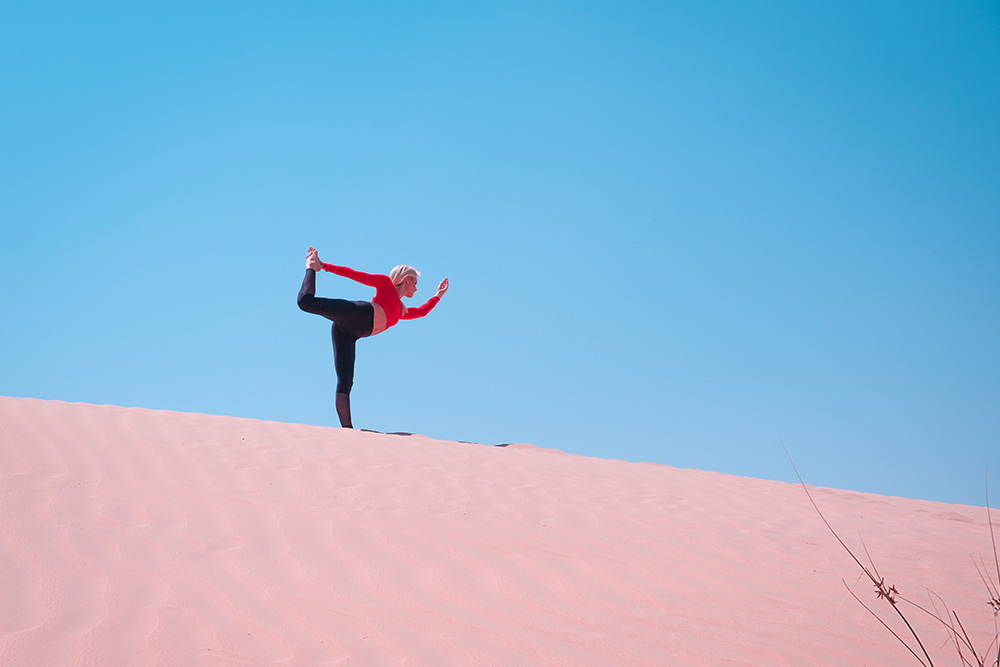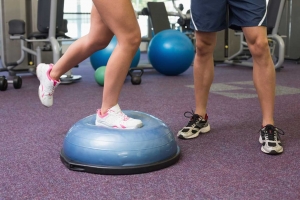Exercises For Improved Balance

Hunter Bennett
As you would be aware, we (as an entire population) are getting older.
To put it simply, we are getting the opportunity to live longer, which is obviously an extremely good thing – however, that isn’t to say that it doesn’t pose its own set of challenges.
You see, as you get older, your physical function tends to decline. This means that you see reductions in muscle strength, power, and endurance, in combination with decreases in balance and coordination.
All of which can contribute to an increased risk of falls.
What is risk of falls?
Risk of falls is exactly what it sounds like – your risk of falling over.
While this may not sound all that dangerous to you on an individual level at the moment, it might be soon. Scarily, falls have gradually become one of the biggest causes disability and morbidity in the elderly on the planet.
This is because as you get older, two rather serious changes happen to your body:
- Firstly, the amount of muscle mass you carry declines.
- Secondly, your bone density reduces.
This means that when you fall, you have less padding (from a decline in muscle mass), and your bones are more brittle – and as a result, you are at a much greater risk of incurring a very serious injury if you happen to fall over.
This means hip fractures, arm fractures, and even spinal damage.
It really does become the perfect storm for a life-changing injury occurring.
Related Article: The Top 3 Tips To Improve Your Balance
At what age does the risk of falls start going up
It is well established that muscle strength and size in sedentary individuals will start to decline around the age of 30 years, while bone mineral density will start to decline around the age of 40 years (Keller, 2013; Khosla, 2005).
Interestingly, the risk of falls doesn’t really start to increase significantly until the age of 60 years (WHO, 2007).
Which indicates that muscle mass and strength are not the only important factors at play here…
The importance of balance
When it comes to keeping yourself safe and fall free, then it is hard to look past the importance of balance.
Human balance is a multidimensional concept that has been defined as the ability of a person not to fall. In this manner, it encompasses the ability to maintain posture during any stationary position, or any dynamic activity (Pollock, 2000).
As simple as this may sounds, balance is actually quite complex, as your ability to maintain balance is dictated heavily by a number of different factors, which include (Horak, 2006):
- Mobility restraints: can refer to any limitations in joint mobility that may impact your ability to move effectively.
- Stability limitations: can refer to an inability to stabilize a joint or limb effectively during movement. This can very much be driven by limitations in muscle strength, which results in a loss of movement control.
- Nervous system and sensory deficits: can refer to anything that results in discord between the nervous and sensory systems, and the muscular system. For example, limitations in neuromuscular control and mechanical sense, and functional declines in the auditory and visual sensory systems.
- Cognitive processing issues: can refer to any declines in cognitive function. All actions require some degree of cognitive processing. The more demanding the task, the more cognitive processing is required to perform it effectively.
Taking all of this into consideration, if you have limitations in any one of these areas, you are likely to experience reductions in balance – which is not a good thing.
How does balance affect fall rate?
Hopefully, you are starting to see the importance of balance.
You see, there is a vast body of research clearly demonstrating that those individuals who exhibit poor balance are at a much greater risk of falling than those who do not (Thapa, 1996; Hilliard, 2008; Pus, 2017).
Which I guess makes quite a bit of sense when you think about it.
Balance is what dictates your capacity to control your body through space during movement tasks. If your balance is poor, then the degree of control you have is going to be markedly less – which is going to result in you losing balance and falling.
Does brain health affect balance?
Now, you might be wondering about brain health and balance – and this is where things get a little interesting.
I have already touched on the fact that cognitive function can impact your balance in a big way – but I didn’t really outline how this relates to the health of your brain.
Under normal circumstances, age has been shown to result in a loss of brain mass, brain plasticity, and brain function. These changes can collectively contribute to declines in cognitive function, which in turn, causes a decline in balance (Rogge, 2017).
It is for this reason that looking after the health of your brain is so damn important.
However, on a very positive note, there is evidence to suggest that you can not only mitigate these changes as you age but actually, improve the health of your brain using a number of different strategies. These include (Jackson, 2016; Laneri, 2016):
- Performing regular exercise
- Eating a healthy diet full of fresh vegetables, seafood, nuts, and lean meats.
- Actively participating in mindfulness and meditation practices
If you can manage these three things every single day, then you will go a very long way to improving the health of your brain for the entirety of your life.
What medical problems make fall risk higher?
While we are talking about health and balance, I thought it would also be worth mentioning the specific medical problems that can increase your risk of falls considerably (Al-Aama, 2011):
- Sarcopenia (a reduction in muscle mass)
- Reductions in muscle strength
- Depression and anxiety
- Arthritis
- Osteoporosis
- Diabetes
- Obesity
While having one of these medical conditions does not mean that you are definitely going to fall, they do increase you risk or falling substantially – which is something that you need to be aware of.
Best exercises to improve balance
While we have spent the bulk of our time talking about how a loss of balance can result in an increased risk of falling, it is not all doom and gloom. You see, most of the ‘normal’ declines in strength, balance, and cognitive function have been discussing are exacerbated by a sedentary lifestyle.
Conversely, they can actually be rectified through exercise. Consequently, I wanted to touch on three of the best exercises to prevent falls.
Strength Training
As I have already discussed at length, your strength and muscle mass essentially determine your ability to maintain your joint stability – which is integral to your ability to maintain balance during movement.
As a result, increasing your strength offers a fantastic way to improve functional balance!
Incredibly, simply performing lower limb strengthening exercises 2-3 times per week can cause some huge increases in your strength and balance. More importantly, these improvements will continue to occur irrespective of your age (Lee, 2013)
This suggests that it doesn’t matter if you are 35 or 85 – strength training will improve your balance and reduce your risk of falling significantly.
Tai Chi
Tai chi is a unique modality of exercise that is built around of series of gentle movements combined with elements of meditation, body awareness and controls, and attention to breathing. As a result, it is commonly sued to improve strength, coordination, and fitness in older populations.
Interestingly, there is also some recent research demonstrating that it can have a huge impact on your balance (Nguyen, 2012).
This research has shown that choosing to perform Tai Chi for as little as twice per week can cause a marked improvement in balance in older individuals. Amazingly, this appears to come with increases in cognitive function as well.
Talk about bang for your buck!
Balance specific training
Balance specific training is a mode of exercise that prioritizes improvements in coordination and walking ability. It is most commonly comprised of different movements that reduce your base of support.
For example, walking on a thin line (drawn on the ground) using heel-to-toe steps for a set distance, or standing on one leg for a long duration of time. These exercises (and other exercises much like these) can then be regressed and progressed as needed, to make them more or less challenging.
Performing this type of training for as little as an hour per week has been shown to lead to improved balance, and a significantly lower risk of falls (Madureira, 2007).
This type of training may offer one of the best entry-level balance exercises for seniors as they don’t require any equipment, are quite easy, and cone be done at home.
Related Article: How Core Strength Effects Athletic Performance
Best tips to improve balance
Last but not least, I wanted to put summarise everything in this article into a list of tips that you can use to improve your balance. You can think of these tips as a weekly checklist that will keep your balance high, and your risk of falls low:
- Participate in 150 minutes of moderate intensity aerobic exercise per week.
- Perform 2 sessions of strength training per week (with a lower body focus).
- Perform an additional session of balance training or Tai Chi each week.
- Try and undertake a 5-10 minutes of mindfulness or meditation 4-5 days per week.
- Eat a diet that is rich in vegetables, fruits, eggs, seafood, nuts, seeds, and lean meat, every single day.
If you can tick off each of these, then you can be pretty certain that your risk of falls will stay very low, no matter your age!
Take Home Message
As you age, it is common to see declines in strength, muscle mass, cognitive function, and worst of all, balance. These declines can seriously limit your ability to move effectively on a day to day basis, which will substantially increase your risk of falling.
Not good…
But it doesn’t have to be this way.
By taking steps to maintain your brain health and your physical function, you can keep your balance high and reduce your risk of falls in a very big way – so what are you waiting for?
References
Keller, Karsten, and Martin Engelhardt. “Strength and muscle mass loss with aging process. Age and strength loss.” Muscles, ligaments and tendons journal 3.4 (2013): 346.
Khosla, Sundeep, and B. Lawrence Riggs. “Pathophysiology of age-related bone loss and osteoporosis.” Endocrinology and Metabolism Clinics 34.4 (2005): 1015-1030.
World Health Organization (WHO). Global age-friendly cities: A guide. World Health Organization, 2007.
Pollock, Alexandra S., et al. “What is balance?.” Clinical Rehabilitation 14.4 (2000): 402-406.
Horak, Fay B. “Postural orientation and equilibrium: what do we need to know about neural control of balance to prevent falls?.” Age and ageing 35.suppl_2 (2006): ii7-ii11.
Thapa, Purushottam B., et al. “Clinical and biomechanical measures of balance fall predictors in ambulatory nursing home residents.” The Journals of Gerontology Series A: Biological Sciences and Medical Sciences 51.5 (1996): M239-M246.
Hilliard, Marjorie Johnson, et al. “Lateral balance factors predict future falls in community-living older adults.” Archives of physical medicine and rehabilitation 89.9 (2008): 1708-1713.
Pua, Yong-Hao, et al. “Falls efficacy, postural balance, and risk for falls in older adults with fall-related emergency department visits: a prospective cohort study.” BMC Geriatrics 17.1 (2017): 291.
Rogge, Ann-Kathrin, et al. “Balance training improves memory and spatial cognition in healthy adults.” Scientific reports 7.1 (2017): 5661.
Jackson, Philippa A., et al. “Promoting brain health through exercise and diet in older adults: a physiological perspective.” The Journal of physiology 594.16 (2016): 4485-4498.
Laneri, Davide, et al. “Effects of long-term mindfulness meditation on brain’s white matter microstructure and its aging.” Frontiers in aging neuroscience 7 (2016): 254.
Al-Aama, Tareef. “Falls in the elderly: spectrum and prevention.” Canadian Family Physician 57.7 (2011): 771-776.
Lee, In-Hee, and Sang-young Park. “Balance improvement by strength training for the elderly.” Journal of physical therapy science 25.12 (2013): 1591-1593.
Nguyen, Manh Hung, and Andreas Kruse. “A randomized controlled trial of Tai chi for balance, sleep quality and cognitive performance in elderly Vietnamese.” Clinical interventions in aging 7 (2012): 185.
Madureira, Melisa M., et al. “Balance training program is highly effective in improving functional status and reducing the risk of falls in elderly women with osteoporosis: a randomized controlled trial.” Osteoporosis international 18.4 (2007): 419-425.










